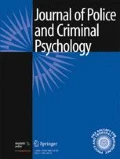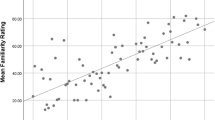Abstract
The present studies examined jurors’ perceptions of “familiar” identifications—that is, identifications where an eyewitness espouses prior exposure to the perpetrator. In two studies, undergraduate mock jurors (total N = 760) read a criminal case vignette that manipulated whether the eyewitness claimed to have prior exposure to the perpetrator (and how much). Study 1 additionally manipulated the eyewitness’ subsequent lineup identification confidence level, finding that confidence (but not familiarity) increased participants’ beliefs in guilt and identification accuracy. Study 2 employed a stronger familiarity manipulation while additionally manipulating how long before the crime the prior exposure occurred and the viewing conditions during the crime. Results indicated that this stronger familiar identification was perceived as more accurate and indicative of guilt than the stranger identification, but only in cases of minimal prior exposure. And while viewing conditions independently affected legal judgments, it rarely moderated these familiarity effects. Theoretical and applied implications are discussed.






Similar content being viewed by others
Notes
In our initial investigation we also manipulated the age of the eyewitness (15, 45, or 75 years old). Due to the exploratory nature of this manipulated variable and because it is beyond the purpose and scope of the present study, this variable is not reported in the manuscript.
Due to a data collection error regarding the dichotomous guilt variable in Study 1, we report the results of the continuous measures throughout both studies to provide a more consistent picture regarding the effects of our variables and to assist the reader’s comprehension of the results. It is noteworthy that similar results emerged for the dichotomous and continuous measures.
There was a marginally significant Familiarity × Confidence interaction on perceptions of whether the defendant was the shooter, F(1, 326) = 3.58, p = .06. Simple effects analyses revealed that while confidence did not affect participants’ stranger identification judgments, F(1, 329) = 0.16, p = .69, they did affect participants’ familiar identification judgments, F(1, 329) = 14.24, p < .001. Specifically, participants were more likely to perceive the defendant was the shooter in the high confidence (M = 4.66, SD = 1.27) than in the low confidence condition (M = 3.96, SD = 1.36).
We acknowledge that a sizeable number of participants were excluded from our primary analyses, but believe that such exclusion was necessary to obtain a more reliable and generalizable assessment of mock jurors’ opinions on this issue. We also note that data analyses with all participants generally produced a similar pattern of results.
These questions were only given to participants in the familiarity conditions because they addressed the likelihood that the eyewitness confused the perpetrator with the individual they had seen before, which is only a possibility in the prior exposure conditions. As a result, this question would not make sense to participants in the stranger identification condition.
The same question was also administered in Study 1. As few participants in Study 1 endorsed exposure to eyewitness memory issues, we only used this variable as a covariate in Study 2.
We did not conduct a MANOVA after assessing correlations among the dependent measures because we believe that guilt and identification accuracy tap into separate decisions.
We also conducted a series of 3 (Familiarity Extent and Familiarity Recency) × 2 (View) ANOVA’s which produced the same results, namely significant Familiarity Extent and Familiarity Recency main effects, and no Familiarity × View interactions.
An amicus brief is a report written by an outside party to the litigation (often termed “friend of the court”) to assist or advocate for a particular legal decision.
References
Asai C (2001) The effect of familiarity on eyewitness identification testimony: the relationship between accuracy and confidence. Shinrigaku Kenkyu 72:283–289
Bornstein BH (1999) The ecological validity of jury simulations: is the jury still out? Law Hum Behav 23:75–91. https://doi.org/10.1023/A:1022326807441
Bornstein BH, Deffenbacher KA, Penrod SD, McGorty EK (2012) Effects of exposure time and cognitive operations on facial identification accuracy: a meta-analysis of two variables associated with initial memory strength. Psychol Crime Law 18(5):473–490
Bornstein BH, Golding JM, Neuschatz J, Kimbrough C, Reed K, Magyarics C, Luecht K (2017) Mock juror sampling issues in jury simulation research: a meta-analysis. Law Hum Behav 41:13–28. https://doi.org/10.1037/lhb0000223
Brewer N, Burke A (2002) Effects of testimonial inconsistencies and eyewitness confidence on mock-juror judgments. Law Hum Behav 26:44–56
Brief for the Appellant as amicus curiae, Connecticut v. Guilbert, S. C. 17948 (2012)
Bruce V (2012) Familiar face recognition. In Wilkinson C, Ryan C (Eds), Craniofacial identification. Cambridge University Press
Bruce VJ, Henderson Z, Newman C, Burton AM (2001) Matching identities of familiar and unfamiliar faces caught on CCTV images. J Exp Psychol Appl 7:207–218
Coleman J, Zoeller E, Newman T, Vidmar N (2012) Don’t I know you? The effects of prior acquaintance/familiarity on witness identification. The Champion, www.nacdl.org
Commonwealth v. Williams, 146 Conn (2015) App. 120
Cutler BL, Penrod SD, Stuve TE (1988) Juror decision making in eyewitness identification cases. Law Hum Behav 12:41–55
Cutler BL, Penrod SD, Dexter HR (1990) Juror sensitivity to eyewitness identification evidence. Law Hum Behav 14:185–191
Deffenbacher KA, Bornstein BH, McGorty EK, Penrod SD (2008) Forgetting the once-seen face: estimating the strength of an eyewitness’s memory representation. J Exp Psychol Appl 14:139–150
DeJong M, Wagenaar WA, Wolters G, Verstijnen IM (2005) Familiar face recognition as a function of distance and illumination: a practical tool for use in the courtroom. Psychol Crime Law 11:87–97
Devine DJ, Clayton LD, Dunford BB, Saying R, Pryce J (2001) Jury decision-making: 45 years of empirical research on deliberating groups. Psychol Public Policy Law 7:622–727
Dillickrath T (2001) Expert testimony on eyewitness identification: admissibility and alternatives. Univ Miami Law Rev 55:1059–1100 Available at: http://repository.law.miami.edu/umlr/vol55/iss4/29
Ellison L, Munro VE (2010) Getting to (not) guilty: examining jurors’ deliberative processes in, and beyond, the context of a mock rape trial. Leg Stud 30:74–97. https://doi.org/10.1111/j.1748-121X.2009.00141.x
Ellison L, Munro VE (2014) A ‘special’ delivery? Exploring the impact of screens, live-links and video-recorded evidence on mock juror deliberation in rape trials. Soc Legal Stud 23:3–29. https://doi.org/10.1177/0964663913496676
Federal Rules of Evidence. Rule 702. Testimony by Expert Witnesses (2011)
Flowe HD, Mehta A, Ebbesen EB (2011) The role of eyewitness identification evidence in felony case dispositions. Psychol Public Policy Law 17:140–159
Gobbini MI, Haxby JV (2007) Neural systems for recognition of familiar faces. Neuropsychologia 45:32–41
Green DM, Swets JA (1966/1974) Signal detection theory and psychophysics. Huntington, NY: Robert E. Krieger Publishing Co
Johnson MK, Hashtroudi S, Lindsay DS (1990) Source monitoring. Psychol Bull 114:3–28
Johnston RA, Edmonds AJ (2009) Familiar and unfamiliar face recognition: a review. Memory 17:577–596
Kerstholt JH, Raaijmakers GW, Valeton JM (1992) The effect of expectation in the identification of known and unknown persons. Appl Cogn Psychol 6:173–180
Leippe MR, Eisenstadt D (2009) The influence of eyewitness expert testimony on jurors’ beliefs and judgments. In: Cutler BL (ed) Expert testimony on the psychology of eyewitness identification. Erlbaum, Mahwah, NJ, pp 169–199
Lindsay RCL, Wells GL, Rumpel CM (1981) Can people detect eyewitness-identification accuracy within and across situations? J Appl Psychol 66:79–89
Lindsay RCL, Wells GL, O’Connor FJ (1984, 1989) Mock juror belief of accurate and inaccurate eyewitnesses: a replication and extension. Law Hum Behav, 13, 333–339
Loftus EF (1997) Creating false memories. Sci Am 277:70–75
Loftus EF, Palmer JC (1974) Reconstruction of automobile destruction. An example of the interaction between language and memory. J Verbal Learn Verbal Behav 13:585–589
Loftus EF, Miller DG, Burns HJ (1978) Semantic integration of verbal information into a visual memory. J Exp Psychol Hum Learn Mem 4:19–31
Lucas CA, Brewer N (2015) Eyewitness identification when the perpetrator “reminds me of someone I know.”. Psychiatry Psychol Law 22:49–59. https://doi.org/10.1080/13218719.2014.918082
Pezdek K, Roe C (1995) The effect of memory trace strength on suggestibility. J Exp Child Psychol 60:116–128
Pezdek K, Stolzenberg S (2014) Are individuals’ familiarity judgments diagnostic of prior contact? Psychol Crime Law 20:302–314. https://doi.org/10.1080/1068316X.2013.772181
Pozzulo J, Pettalia JL, Bruer K, Javaid S (2014) Eyewitness age and familiarity with the defendant: influential factors in mock jurors’ assessment of guilt. Am J Forensic Psychol 32:39–51
R v. Turnbull, 63 Cr App R 132 (1976)
Schwaninger, A., Lobmaier, J. S., & Collishaw, S. M. (2002). Role of featural and configural information in familiar and unfamiliar face recognition. In Bülthoff H.H., Wallraven C., Lee S. W., & Poggio T.A. (Eds.) Biologically motivated computer vision. BMCV 2002. Lecture Notes in Computer Science, vol 2525. Springer, Berlin, Heidelberg
Sheahan CL, Pozzulo JD, Reed JE, Pica E (2017) The role of familiarity with the defendant, type of descriptor discrepancy, and eyewitness age on mock jurors’ perceptions of eyewitness testimony. J Police Crim Psychol. Advanced Online Publication 33:35–44. https://doi.org/10.1007/s11896-017-9232-2
State of Kansas v. Trotter, 280 Kan. 800 (2006)
State of New Jersey v. Henderson, 208 N.J. 208 (2011)
State of Utah v. Bruce, 779 P.2d 646 (1989)
United States v. Wade, 388 U.S. 218 (1967)
Wells GL, Olson EA (2003) Eyewitness testimony. Annu Rev Psychol 54:277–295
Wells GL, Ferguson TH, Lindsay RCL (1981) The tractability of eyewitness confidence and its implications for triers of fact. J Appl Psychol 66:688–696
Wise RA, Dauphinais KA, Safer MA (2007) A tripartite solution to eyewitness error. J Crim Law Crim 97:807–871 http://scholarlycommons.law.northwestern.edu/jclc/vol97/iss3/4
Acknowledgements
I would like to thank Kristen Slapinski, Abigail Briggs, and Kelly Lawson for their assistance with this manuscript.
Author information
Authors and Affiliations
Corresponding author
Rights and permissions
About this article
Cite this article
Vallano, J.P., Pettalia, J., Pica, E. et al. An Examination of Mock Jurors’ Judgments in Familiar Identification Cases. J Police Crim Psych 34, 121–133 (2019). https://doi.org/10.1007/s11896-018-9266-0
Published:
Issue Date:
DOI: https://doi.org/10.1007/s11896-018-9266-0



